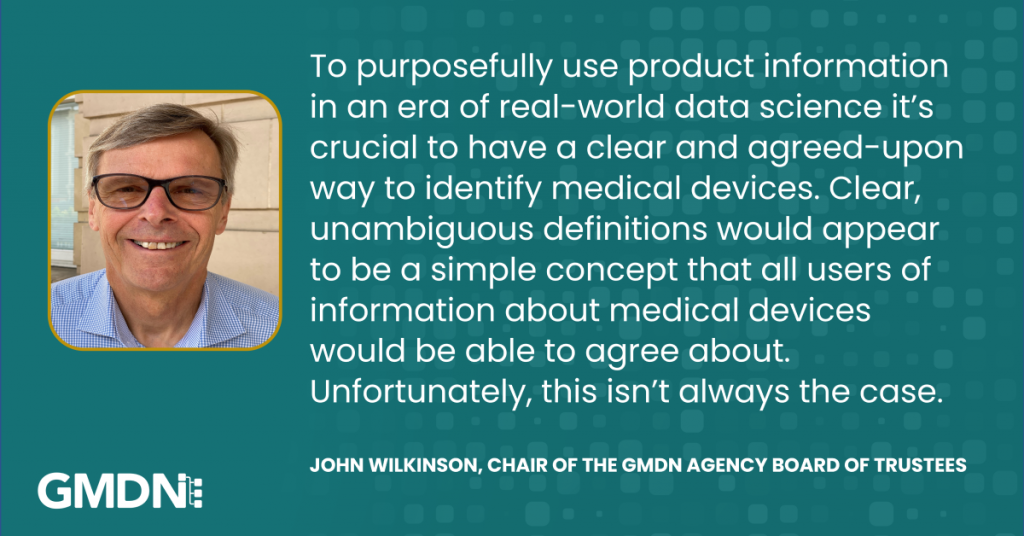Blog - The importance of a universal definition for medical devices

4 September 2024
By John Wilkinson, Chair of the Board of Trustees, GMDN Agency
To purposefully use product information in an era of real-world data science it’s crucial to have a clear and agreed-upon way to identify medical devices. Clear, unambiguous definitions would appear to be a simple concept that all users of information about medical devices would be able to agree about. Unfortunately, this isn’t always the case.
As in many walks of life, organisations tend to believe that their goals and purposes are unique and demand a customised approach to core elements of the datasets that they depend on. The result of this is multiple variants of data inputs that appear to serve the same purpose. These variants act as a huge impediment to sharing and pooling data. In some sectors this tendency just adds overhead and complexity but in healthcare the consequences are more profound and have significant patient safety implications.
I hold a firm view that a single definition for a medical device can and should be used in all contexts and there is little or no justification for serial nomenclatures designed for specific contexts. If a medical device is well defined (a particular skill set) it can and should be used in all contexts. A medical device remains the same whether it’s in development, pre-market, post-market, or in the supply chain and procurement stages. The definition should be the same for all purposes and use of a standardised nomenclature can serve the full life-cycle of a product allowing unambiguous exchange of information across the full spectrum of applications.
The Global Medical Device Nomenclature was developed and designed to fulfil this universal role albeit with a focus on regulatory processes. It is now increasingly evident that using GMDN across all domains adds to the efficiency of regulatory processes by enhancing the ability to access supply chain information. This helps regulators carry out recalls and validate vigilance investigations. The same definitions can also help supply-chain, procurement, and asset management operations by facilitating data analysis of product within the supply chain, commissioned in provider institutions and for the accurate prescription of products for tendering and contracting. Use of a common nomenclature in regulatory, institutional and supply chain applications are thus complementary.
It is understandable that different organisations might feel that they need to group and analyse product data in different ways for different purposes. For instance, regulators may want to analyse adverse event data by broad clinical application whereas supply chain operations may wish to organise data by grouping relevant to shipping constraints. These differing needs can be accommodated by specific grouping overlays which are customised to the needs of the specific activity. All depend on clear, well defined, and unambiguous definitions as the bedrock of utility.
A harmonised nomenclature with strong processes and governance can provide continuously updated information to all organisations with an interest in medical devices at minimal cost to the sector globally. Multiple nomenclatures create ambiguity, which may have patient safety implications, and add costs to the total system either via duplication or forcing organisations to commit resources to maintaining multiple systems to accommodate the duplication.
The case for a single universally applied nomenclature is more than compelling. It is just common sense. For those interested in the more complex discussions around a fully functioning nomenclature our recent white paper titled ‘Medical Device Nomenclature – What Next Globally?’ is essential reading.
The GMDN team is highly qualified and skilled in delivering a uniquely sophisticated service to the global medical device community which serves its stakeholders effectively in an increasingly complex and dynamic world.
This service is easy to use, despite the complexity of the work behind the scenes. Just like how I don’t need to understand how my hybrid car works to drive it, users don’t need to understand the complexities of the GMDN to benefit from it.
Recent Posts
- GMDN FOCUS – March 2025 March 31, 2025
- Global Medical Device Nomenclature (GMDN): A valuable tool for the development of National Essential Diagnostics Lists (NEDLs) March 25, 2025
- GMDN Agency joins Joint Initiative Council to advance global health informatics March 4, 2025
- GMDN FOCUS – February 2025 February 28, 2025
- Shaping Our Future: Insights and Actions from the GMDN Agency’s 2024 Annual Survey February 27, 2025
